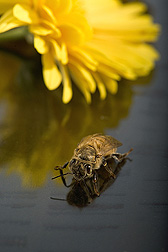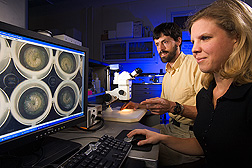Honey Bee Genetics Vital in Disease Resistance
|
|
As pollinators and food providers, honey bees are a key beneficial insect. They pollinate about 130 fruit, vegetable, nut, ornamental, and fiber crops in the United States. In all, their efforts contribute about $15 billion annually through improved crop yield and product quality in the form of larger or more appealing fruits. Sale of hive products—honey, wax, pollen, royal jelly, and even venom—generates hundreds of millions more.
Thanks in large part to their agricultural importance and potential to inform human medicine, honey bees recently joined an elite group. They’re among the first insects whose entire genomes have been unveiled before scientists. The Honey Bee Genome Project became a reality in late 2002, with funding provided by the U.S. Department of Agriculture and the National Institutes of Health, an organization interested in using bees as a model for understanding human health. The effort has already provided a significant new source of genes for study. The functions of these genes can be assessed through various high-tech methods. Genes can then be connected to disease resistance or other desirable traits, providing new tools for breeding and scoring honey bee lines that can cope with the challenges faced by bees today.
|
|
“This genome project has produced a tremendous amount of information and online resources,” says entomologist Jay Evans, at the Bee Research Lab in Beltsville, Maryland. “We’re now sifting through this information to find clues to breeding and managing bees in ways that reduce the costs of disease.”
So far, about 150 honey bee genes have been selected for analysis by Evans and his team. They’ve already identified genes from the bee’s immune system that are correlated with a colony’s ability to withstand exposure to important pathogens.
One new resource generated through the bee genome project, “BeeBase,” is a genome analysis and display database headed by scientists at Texas A&M University. It provides specific information on genes implicated in disease resistance and other desirable traits. The site will soon host genomic information for two key honey bee pathogens, the bacterium Paenibacillus larvae (cause of American foulbrood disease) and the fungus Ascosphaera apis (cause of chalkbrood disease). With genomic data for both the honey bee and two of its most threatening pathogens, it is now possible to determine how the pathogens succeed in killing bees and, more importantly, how some bees seem to do just fine in the face of pathogens.
|
|
To further explore honey bee disease, reproduction, and behavior, Evans and collaborators are now developing a gene chip, or microarray, that will allow activity levels of individual genes to be measured. The goal is to better define the genetic bases of important traits and then give bee breeders a better way to bring out sought-after genetic traits, such as disease resistance, and to ward off undesirable traits, such as the defensive behaviors of Africanized honey bees.—By Alfredo Flores, Agricultural Research Service Information Staff.
This research is part of Crop Production, an ARS National Program (#305) described on the World Wide Web at www.nps.ars.usda.gov.
Jay D. Evans is in the USDA-ARS Bee Research Laboratory, 10300 Baltimore Avenue, Beltsville, MD 20705; phone (301) 504-5143, fax (301) 504-8736.
"Honey Bee Genetics Vital in Disease Resistance" was published in the January 2007 issue of Agricultural Research magazine.









